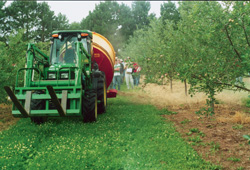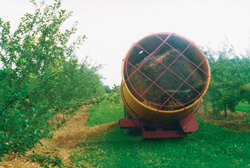
Features
Production
Research
Apogee a success following first year of use in Annapolis Valley
following first year of use in Annapolis Valley
April 1, 2008 By Dan Wooley
Apogee has made a promising debut for orchard management within Nova Scotia’s Annapolis Valley.
 |
| Growers in Nova Scotia’s Annapolis Valley view a mulching demonstration during a recent grower tour. Photos by Dan Wooley |

|
Apogee has made a promising debut for orchard management within Nova Scotia’s Annapolis Valley.
Just registered in early 2005 by the Pest Management Regulatory Agency (PMRA) as a growth regulator, Gordon Lemmon of Starrs Point, Nova Scotia, used “a fair amount of Apogee” in June, noting the recommendation for its early application.
He manages an orchard in the area for J.W. Mason & Sons Ltd. on “very vigorous soil and it is a struggle to keep this block of Macintosh back.”
Now having seen Apogee’s impact on tree growth, Lemmon believes “it is a tool I think will help us a lot on this farm.” He added that he felt it will both help reduce pruning next year and pay for itself.
At Medford, Nova Scotia, Sarsfield Farms Inc. has 19.5 acres of mixed orchard featuring Pioneer Mac, Red Cortland, Jonagold and Honeycrisp, all planted in 2001. Blake Sarsfield applied Apogee once to a portion of the Red Cortland block and noted a big difference between it and the untreated part of the block.
At his Lakeville, Nova Scotia, orchard Stephen Van Meekeren has a 1999 planting of both Red and Golden Delicious, which have traditionally shown “a fair bit of vigour.”
The Golden Delicious “have done OK” but the Red Delicious, said Van Meekeren, “grew like crazy but did not want to have any crop.”
He decided to remove every other tree and apply no fertilizer to the orchard once it began cropping.
This spring, when Apogee became available, Van Meekeren applied it. Initially, it did not appear to be doing much “but now where shoots would have two feet of new growth, it is just eight inches.”
Over at Jonathan Fuller’s farm at Avonport, Nova Scotia, he is facing a vigour control challenge in a 1996 planting of Northern Spy. Since its first crop in 2002, all subsequent harvests have been poor, he explained.
“As far as vigour management, I cross my fingers. That is about all I can do.”
Spy is a hard tree to settle down in a new plot and so he hopes, “within a year, they will kick in and I will start to make some money.” Bill Craig, an Agra Point International tree fruit specialist, recommends against over-fertilizing a planting with vigour problems, adding Fuller’s Spy plot “might be a candidate for Apogee.”
Of course, there are other options to control excess vegetation in favour of fruit growth, such as girdling, scoring and root pruning.
Dr. David Crowe, a retired federal government pomologist, felt scoring might be preferable to girdling and “Apogee is likely a better option than root pruning.”
Root pruning is a technique “used with great caution,” added Craig, “as it can result in smaller fruit.”
Print this page